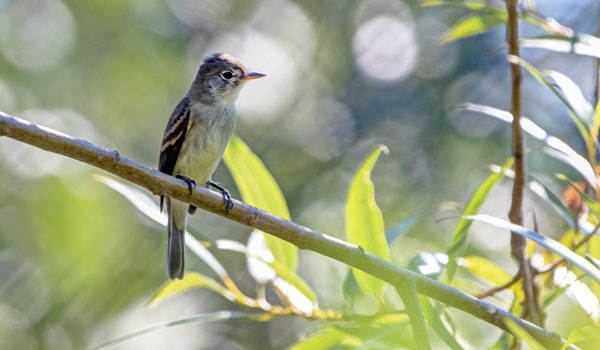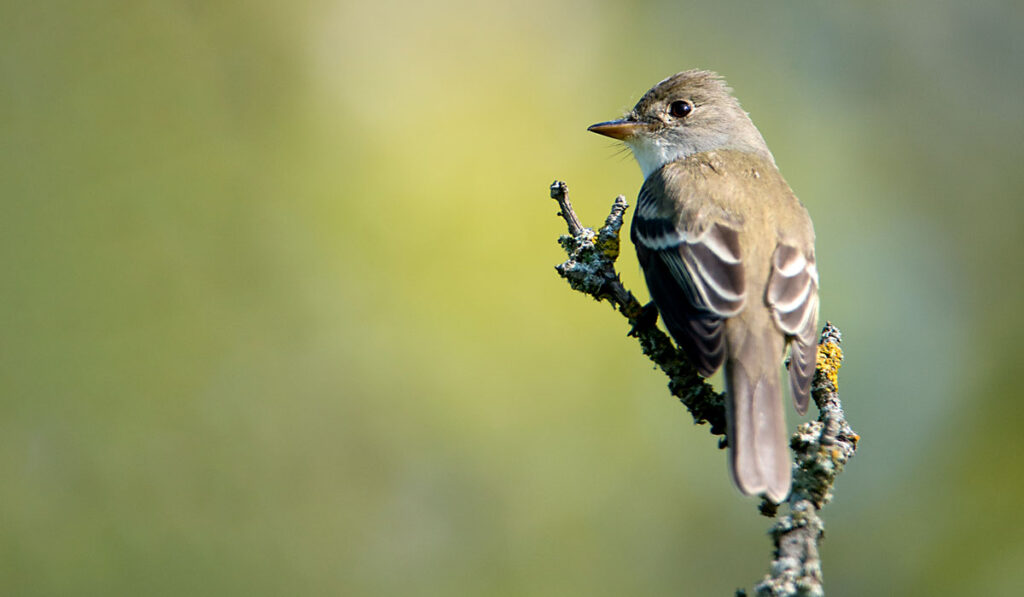
Those of you like Amy, obsessed with watching ABC’s new sitcom Not Dead Yet, may have noticed an episode where Nell’s roommate briefly touched on the Southwestern Willow Flycatcher. Didn’t catch it? Maybe only Amy noticed because it just so happened to be top of mind with Forever Our Rivers.
Why are the Southwestern Willow Flycatchers catching people’s attention—even of the Hollywood writers/producers? They’ve been endangered since 1995, have a huge impact on controlling insect populations, and well, are super cute songbirds.
A small but mighty songbird that relies on riparian habitats.
The Southwestern Willow Flycatcher is a migratory bird that thrives in lush areas along rivers in the southwestern United States and part of Mexico. Their native habitat among willows, box elders and cottonwoods provide important ecosystem services: these trees and shrubs filter sediment from water, improve soil and provide wildlife habitat. Unfortunately, these flycatchers have adapted to nest in thickets of non-native, invasive species such as saltcedar (also known as tamarisk) and Russian Olive. While we praise the birds for their adaptability, saltcedar and Russian olive are wreaking havoc on water quality and quantity in the southwest.
So, you may be wondering, how do we get rid of those invasive species without getting rid of the flycatchers? Don’t worry, we’ll cover that soon.
Flycatchers also eat insects such as mosquitoes, flies, beetles and moths. This helps regulate insect populations, which can have a significant impact on the environment. Occasionally they may eat berries such as blackberries and raspberries, but insects make up over 95% of their diet.
It’s estimated that only 2,500 to 3,000 flycatchers remain.

The Southwestern Willow Flycatcher population had been declining for decades. Climate change and human development such as water diversion, groundwater pumping and building along waterways have not done these birds any favors. Large portions of the flycatcher’s habitat have disappeared throughout much of its historic range. This led to the flycatcher being listed as a federally endangered species in 1995, where it still remains today.
What do we do about this?
Well, the flycatcher is in luck.
Conservation efforts are underway focused on habitat restoration and protection of the Southwestern Willow Flycatcher. One of Forever Our Rivers’ partners, the Gila Watershed Partnership (GWP), is working hard on this huge balancing act.
“Even though trees such as desert willow are the native habitat of these birds, they have adapted to the saltcedar so well that much of the tamarisk thicket along the river has become untouchable due to Endangered Species Act restrictions. These thickets are dense enough to inhibit stream flow”, said Dr. Sarah Sayles, executive director of the Gila Watershed Partnership. Yet efforts to control non-native species such as saltcedar can be detrimental to flycatchers if the plants are removed without suitable native riparian habitat nearby to replace them with. In order to not to lose any habitats for the flycatchers, GWP follows the defoliation of salt cedar—usually done by the tamarisk beetle—by promoting and restoring native plants in their appropriate place along the Gila River.
I bet this question is on the tip of your tongue: Is the population still declining despite all the hard work? According to the American Bird Conservancy, the bird’s population is very slowly increasing. GWP hasn’t yet seen a difference in population but is hopeful. “We have seen the Southwestern Willow Flycatcher out on our work sites in some of the newly planted natives. We’ll continue to restore more and more native habitat for the endangered species of the Gila River. We’re in this for the long-haul”, Dr. Sarah explains.
This is just one example of the restoration work our river partners are doing along tributaries to the Colorado River. Thank you to our amazing nonprofit partners who are out there every day making a difference for the rivers and those that depend on them like the Southwestern Willow Flycatcher!
